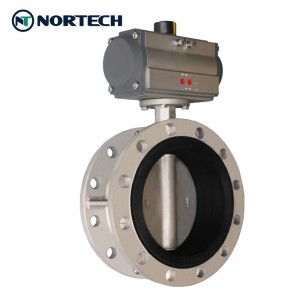At present, the butterfly valve is a component used to realize the on-off and flow control of the pipeline system.
It has been widely used in many fields such as petroleum, chemical industry, metallurgy, hydropower and so on. In the known butterfly valve technology, its sealing form mostly adopts a sealing structure,
The sealing material is rubber, polytetraoxyethylene, etc. Due to the limitation of structural characteristics, it is not suitable for industries such as high temperature resistance, high pressure resistance, corrosion resistance, and wear resistance.
An existing relatively advanced butterfly valve is a triple-eccentric metal hard-sealed butterfly valve. The broad body and the valve seat are connected components, and the sealing surface layer of the valve seat is welded with temperature-resistant and corrosion-resistant alloy materials.
The multi-layer soft laminated sealing ring is fixed on the valve plate. Compared with the traditional butterfly valve, this kind of butterfly valve has high temperature resistance, is easy to operate, and has no friction when opening and closing. When closing, the torque of the transmission mechanism increases to compensate for the sealing.
Improve the sealing performance of the butterfly valve and the advantages of prolonging the service life.
However, this butterfly valve still has the following problems during use
Since the multi-layer soft and hard laminated sealing ring is fixed on the broad plate, when the valve plate is normally open, the medium will form a positive scouring on its sealing surface, and the soft sealing band in the metal sheet sandwich will directly affect the sealing performance after being scoured.
Limited by the structural conditions, this structure is not suitable for valves with a diameter below DN200, because the overall structure of the valve plate is too thick and the flow resistance is large.
Due to the principle of the triple eccentric structure, the seal between the sealing surface of the valve plate and the valve seat relies on the torque of the transmission device to press the broad plate against the valve seat. In the positive flow state, the higher the medium pressure, the tighter the sealing extrusion.
When the flow channel medium flows back, as the medium pressure increases, the unit positive pressure between the valve plate and the valve seat is less than the medium pressure, the seal begins to leak.
The high-performance three-eccentric two-way hard sealing butterfly valve is characterized in that the wide seat sealing ring is composed of multiple layers of stainless steel sheets on both sides of a soft T-shaped sealing ring. The sealing surface of the slab and the valve seat is an oblique cone structure,
The surface of the oblique cone of the valve plate is welded with temperature-resistant and corrosion-resistant alloy materials; the spring fixed between the pressure plate of the adjusting ring and the adjusting bolt of the pressure plate are assembled together.
This structure effectively compensates for the tolerance zone between the shaft sleeve and the valve body and the elastic deformation of the broad rod under the medium pressure, and solves the sealing problem of the valve in the two-way interchangeable medium conveying process.
The sealing ring is composed of a soft T-shaped multi-layer stainless steel sheet on both sides, which has the dual advantages of a metal hard seal and a soft seal, and has a sealing performance of zero leakage regardless of low temperature and high temperature.
The test proves that when the pool is in a positive flow state (the flow direction of the medium is the same as the rotation direction of the butterfly plate), the pressure on the sealing surface is generated by the torque of the transmission device and the action of the medium pressure on the valve plate.
When the positive medium pressure increases, the tighter the oblique cone surface of the valve plate and the sealing surface of the valve seat are pressed, the better the sealing effect. In the reverse flow state, the seal between the valve plate and the valve seat depends on the torque of the driving device to press the valve plate against the valve seat.
With the increase of the reverse medium pressure, when the unit positive pressure between the valve plate and the valve seat is less than the medium pressure,
The stored deformation energy of the spring of the adjusting ring after being loaded can compensate the tight pressure of the sealing surface of the valve plate and the valve seat to automatically compensate.
Therefore, unlike the prior art, the utility model does not install a hard multi-layer sealing ring on the valve plate, but directly installs it on the valve body. The addition of an adjustment ring between the pressure plate and the valve seat is a very ideal two-way hard sealing method. .
It can replace gate valves, globe valves and globe valves.
Post time: Jun-23-2021

